


Adult Orthodontics
Orthodontics works for all age groups, though the aims of treatment can change with age.
This is called age appropriate orthodontics and will modify the treatment plan suggested. It is never too late to explore the option of cosmetic dentistry and to have the smile you deserve.
However, Orthodontics can benefit adults not only by improving their smile but also helping periodontal problems, improving the ability of dentists to restore your dentition, improving function and oral health, and like teenagers – adults benefit from improved self esteem and self confidence on completion.
We understand that all of our patients have differing treatment preferences and adults often appreciate as quick and efficient an orthodontic treatment plan as possible.
Symmetry Orthodontics is an accredited Invisalign provider on the Sunshine Coast, offering you the option of transparent aligners which provide a practically invisible option to braces. Invisalign enables you to straighten your teeth without anyone even knowing!
Ask your dentist for a referral or ring us direct for an orthodontic consultation and peace of mind.
Ask a question or book an appointment
07 5352 3500
Orthodontic Treatments for Adults
Prevent dental problems before they occur and choose Symmetry Orthodontics for quality adult orthodontic treatments.
Problems in Adults
There are a number of issues affecting adults that can be addressed by orthodontic treatment.
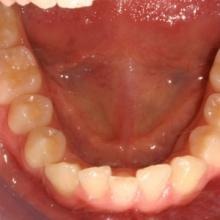
Dental crowding is one of the most common orthodontic problems. It exists when the total size of the teeth is larger than the total size of the jaw-bone that holds them. Minor crowding can be corrected solely with braces. Moderate and severe crowding situations may require additional treatment prior to braces – such as palatal expansion, tooth size reduction or extractions in some severe cases.
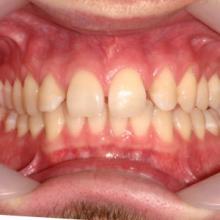 Spacing is the opposite of crowding and is an excess of available space resulting in gaps between the teeth. This generally occurs when the collective size of all the teeth are smaller than the jaws they sit in.
Spacing is the opposite of crowding and is an excess of available space resulting in gaps between the teeth. This generally occurs when the collective size of all the teeth are smaller than the jaws they sit in.
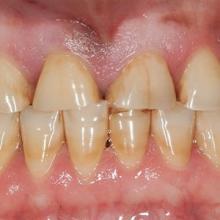 Tooth wear results from a bite whereby there is not an ideal anatomical meeting of the teeth. The two surfaces contact out of balance and you will preferentially use the front or back, left or right teeth to grind. Over time the enamel is worn down and with that the front teeth present as shorter with an edge to edge bite. The restoration of this condition requires a general dental solution, however correct positioning by orthodontics prior to this restoration can be advantageous.
Tooth wear results from a bite whereby there is not an ideal anatomical meeting of the teeth. The two surfaces contact out of balance and you will preferentially use the front or back, left or right teeth to grind. Over time the enamel is worn down and with that the front teeth present as shorter with an edge to edge bite. The restoration of this condition requires a general dental solution, however correct positioning by orthodontics prior to this restoration can be advantageous.
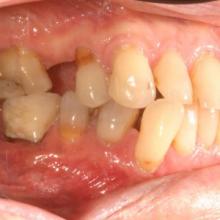 Periodontal diseases are infections of the gums and bone that surround the teeth. In its early stage, called gingivitis, the gums can become swollen and red, and they may bleed. In its more serious form, called periodontitis, the gums can pull away from the tooth, bone can be lost, and the teeth may loosen or even fall out. An early diagnosis of the disease, and associated difficulty of plaque removal from crowded teeth, can be rectified by moving the teeth into a correct alignment for easier home care.
Periodontal diseases are infections of the gums and bone that surround the teeth. In its early stage, called gingivitis, the gums can become swollen and red, and they may bleed. In its more serious form, called periodontitis, the gums can pull away from the tooth, bone can be lost, and the teeth may loosen or even fall out. An early diagnosis of the disease, and associated difficulty of plaque removal from crowded teeth, can be rectified by moving the teeth into a correct alignment for easier home care.
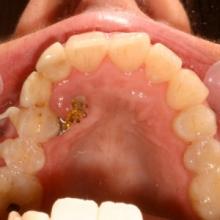 Impacted teeth most commonly present when a baby tooth fails and the patient has been unaware of the lack of eruption of an adult tooth. The roots of the impacted tooth can fuse to the surrounding bone creating a tooth frozen in an unerupted or partially erupted state.
Impacted teeth most commonly present when a baby tooth fails and the patient has been unaware of the lack of eruption of an adult tooth. The roots of the impacted tooth can fuse to the surrounding bone creating a tooth frozen in an unerupted or partially erupted state.
Tipped teeth usually occur when a tooth in front has been lost or is missing. The tipped tooth can become problematic if hygiene becomes impossible or the tooth is required to restore the space for the missing tooth.
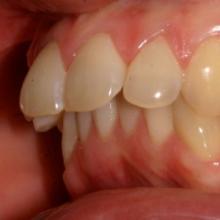 Dental protrusion exists when the top front teeth are too far forward or flared. As an adult presentation, the main concern is usually aesthetic.
Dental protrusion exists when the top front teeth are too far forward or flared. As an adult presentation, the main concern is usually aesthetic.
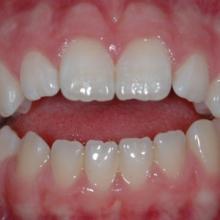 Open bite can either be caused by an oral habit which effects the dentition only, or by a skeletal problem and can be more complicated to correct. Careful diagnosis is important with open bites as they are notoriously difficult to treat. Increasing evidence shows that invisalign is good at correcting these dentally derived open bites.
Open bite can either be caused by an oral habit which effects the dentition only, or by a skeletal problem and can be more complicated to correct. Careful diagnosis is important with open bites as they are notoriously difficult to treat. Increasing evidence shows that invisalign is good at correcting these dentally derived open bites.
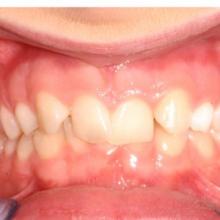 The upper and/or lower front teeth can erupt to produce a deep bite. In severe cases, the upper teeth can cover the lower teeth completely. A deep bite can cause excessive wear of the front teeth and can damage the gum behind the upper front teeth.
The upper and/or lower front teeth can erupt to produce a deep bite. In severe cases, the upper teeth can cover the lower teeth completely. A deep bite can cause excessive wear of the front teeth and can damage the gum behind the upper front teeth.
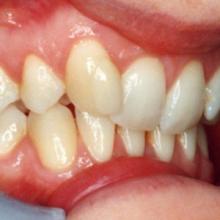 When the face is viewed in profile, the balance of the upper and lower jaws can be classified, when the lower jaw is more prominent than the upper jaw it is termed Complete Class III, in reverse this is class II, when the jaws are in balance it is class I. This traditionally, has been objectively observed in a lateral cephalogram.
When the face is viewed in profile, the balance of the upper and lower jaws can be classified, when the lower jaw is more prominent than the upper jaw it is termed Complete Class III, in reverse this is class II, when the jaws are in balance it is class I. This traditionally, has been objectively observed in a lateral cephalogram.
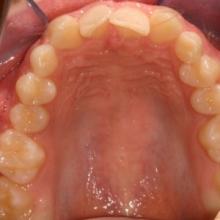 When baby teeth have been retained into adulthood, they can become ankylosed (fused to the bone) and are resistant to movement. The evidence suggests that healthy baby teeth presenting at age 20 should last until approximately 40 but at that age a solution will need to be found for the missing tooth. An alternative to replacing the failed baby tooth, orthodontics can intervene and close the space, negating the need for any further dentistry in later adulthood.
When baby teeth have been retained into adulthood, they can become ankylosed (fused to the bone) and are resistant to movement. The evidence suggests that healthy baby teeth presenting at age 20 should last until approximately 40 but at that age a solution will need to be found for the missing tooth. An alternative to replacing the failed baby tooth, orthodontics can intervene and close the space, negating the need for any further dentistry in later adulthood.

Dental crowding is one of the most common orthodontic problems. It exists when the total size of the teeth is larger than the total size of the jaw-bone that holds them. Minor crowding can be corrected solely with braces. Moderate and severe crowding situations may require additional treatment prior to braces – such as palatal expansion, tooth size reduction or extractions in some severe cases.
 Spacing is the opposite of crowding and is an excess of available space resulting in gaps between the teeth. This generally occurs when the collective size of all the teeth are smaller than the jaws they sit in.
Spacing is the opposite of crowding and is an excess of available space resulting in gaps between the teeth. This generally occurs when the collective size of all the teeth are smaller than the jaws they sit in.
 Tooth wear results from a bite whereby there is not an ideal anatomical meeting of the teeth. The two surfaces contact out of balance and you will preferentially use the front or back, left or right teeth to grind. Over time the enamel is worn down and with that the front teeth present as shorter with an edge to edge bite. The restoration of this condition requires a general dental solution, however correct positioning by orthodontics prior to this restoration can be advantageous.
Tooth wear results from a bite whereby there is not an ideal anatomical meeting of the teeth. The two surfaces contact out of balance and you will preferentially use the front or back, left or right teeth to grind. Over time the enamel is worn down and with that the front teeth present as shorter with an edge to edge bite. The restoration of this condition requires a general dental solution, however correct positioning by orthodontics prior to this restoration can be advantageous.
 Periodontal diseases are infections of the gums and bone that surround the teeth. In its early stage, called gingivitis, the gums can become swollen and red, and they may bleed. In its more serious form, called periodontitis, the gums can pull away from the tooth, bone can be lost, and the teeth may loosen or even fall out. An early diagnosis of the disease, and associated difficulty of plaque removal from crowded teeth, can be rectified by moving the teeth into a correct alignment for easier home care.
Periodontal diseases are infections of the gums and bone that surround the teeth. In its early stage, called gingivitis, the gums can become swollen and red, and they may bleed. In its more serious form, called periodontitis, the gums can pull away from the tooth, bone can be lost, and the teeth may loosen or even fall out. An early diagnosis of the disease, and associated difficulty of plaque removal from crowded teeth, can be rectified by moving the teeth into a correct alignment for easier home care.
 Impacted teeth most commonly present when a baby tooth fails and the patient has been unaware of the lack of eruption of an adult tooth. The roots of the impacted tooth can fuse to the surrounding bone creating a tooth frozen in an unerupted or partially erupted state.
Impacted teeth most commonly present when a baby tooth fails and the patient has been unaware of the lack of eruption of an adult tooth. The roots of the impacted tooth can fuse to the surrounding bone creating a tooth frozen in an unerupted or partially erupted state.
Tipped teeth usually occur when a tooth in front has been lost or is missing. The tipped tooth can become problematic if hygiene becomes impossible or the tooth is required to restore the space for the missing tooth.
 Dental protrusion exists when the top front teeth are too far forward or flared. As an adult presentation, the main concern is usually aesthetic.
Dental protrusion exists when the top front teeth are too far forward or flared. As an adult presentation, the main concern is usually aesthetic.
 Open bite can either be caused by an oral habit which effects the dentition only, or by a skeletal problem and can be more complicated to correct. Careful diagnosis is important with open bites as they are notoriously difficult to treat. Increasing evidence shows that invisalign is good at correcting these dentally derived open bites.
Open bite can either be caused by an oral habit which effects the dentition only, or by a skeletal problem and can be more complicated to correct. Careful diagnosis is important with open bites as they are notoriously difficult to treat. Increasing evidence shows that invisalign is good at correcting these dentally derived open bites.
 When the face is viewed in profile, the balance of the upper and lower jaws can be classified, when the lower jaw is more prominent than the upper jaw it is termed Complete Class III, in reverse this is class II, when the jaws are in balance it is class I. This traditionally, has been objectively observed in a lateral cephalogram.
When the face is viewed in profile, the balance of the upper and lower jaws can be classified, when the lower jaw is more prominent than the upper jaw it is termed Complete Class III, in reverse this is class II, when the jaws are in balance it is class I. This traditionally, has been objectively observed in a lateral cephalogram.
 When baby teeth have been retained into adulthood, they can become ankylosed (fused to the bone) and are resistant to movement. The evidence suggests that healthy baby teeth presenting at age 20 should last until approximately 40 but at that age a solution will need to be found for the missing tooth. An alternative to replacing the failed baby tooth, orthodontics can intervene and close the space, negating the need for any further dentistry in later adulthood.
When baby teeth have been retained into adulthood, they can become ankylosed (fused to the bone) and are resistant to movement. The evidence suggests that healthy baby teeth presenting at age 20 should last until approximately 40 but at that age a solution will need to be found for the missing tooth. An alternative to replacing the failed baby tooth, orthodontics can intervene and close the space, negating the need for any further dentistry in later adulthood.
